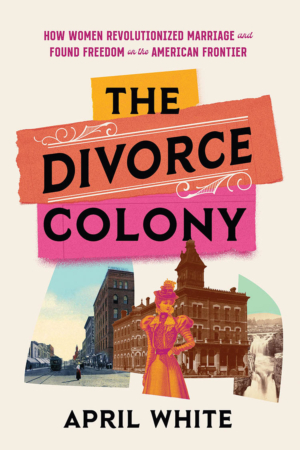I’m leaving.
Wow, those are loaded words and what comes after them pretty much determines how the rest of your day will go. I’m leaving for work is good. I’m leaving this here is fine. I’m leaving you a surprise, very good. But in the 1890s, if for South Dakota was in that sentence, as you’ll see in “The Divorce Colony” by April White, it usually meant just one thing.
Baroness Margaret Laura Astor De Stuers had tried to leave her husband once before, but she was forced back because she was an Astor. It was 1889 and divorce could sully the Astor name, so she was forced to return to her husband. But when the Baron tried to have her committed permanently to a mental institution and she lost custody of her children, Maggie could be deterred no longer.
She headed to Sioux Falls, South Dakota, where, after a short residency in a luxury hotel on the prairie, she could finally get the divorce she wanted.
At that time, says White, the United States had a “patchwork” of divorce laws, each depending on the state’s lawmakers. South Dakota happened to have low residency requirements, meaning that a woman from New York only had to live in the west for a short time before a divorce was awarded. Of course, though, her husband could contest it…
Once was a time when Mary Nevins Blaine and her husband, Jamie, had been happy. That was when they were married: she, the nineteen-year-old daughter of a quiet but respectable family; he, the seventeen-year-old son of a powerful politician who thought Jamie married beneath his social strata. Mary got her divorce, and brought down a Presidential hopeful.
Blanche Molineux had never wanted to get married, and getting out of the one she got was a life-or-death matter: her husband, Roland, had been accused of murder. Flora Bigelow Dodge was known to be fearless but after she married, she feared she’d made a mistake. Smart, creative Flora just wanted peace, and she found it in a prairie town.
Divorce, it seems, is never an easy thing. So imagine what it was like before women had rights, and you’ve got the story inside “The Divorce Colony.”
Indeed, turn-of-the-last-century activists played a role in what happened in Sioux Falls, as did a cross-dressing Civil War physician, a powerful bishop, and a journalist who was hiding a secret. Author April White brings each of these figures to the table, placing them proper context so readers get a good feel for this surprising sliver of history.
Don’t think, though, that this is just boy-leaves-girl stuff. The stories White tells happened at the end of the Wild West days, and most of them reflect that; others are delightfully set in opulence. You’ll snicker a little (Oh, the scandal!) and your jaw will drop a time or three because this book is fascinating, unique, and perfect for historians, readers of women’s issues, and historical novel lovers. Start “The Divorce Colony,” and you’ll have a hard time leaving.
“The Divorce Colony: How Women Revolutionized Marriage and Found Freedom in the American Frontier” by April White
c.2022, Hachette
$30.00
304 pages




